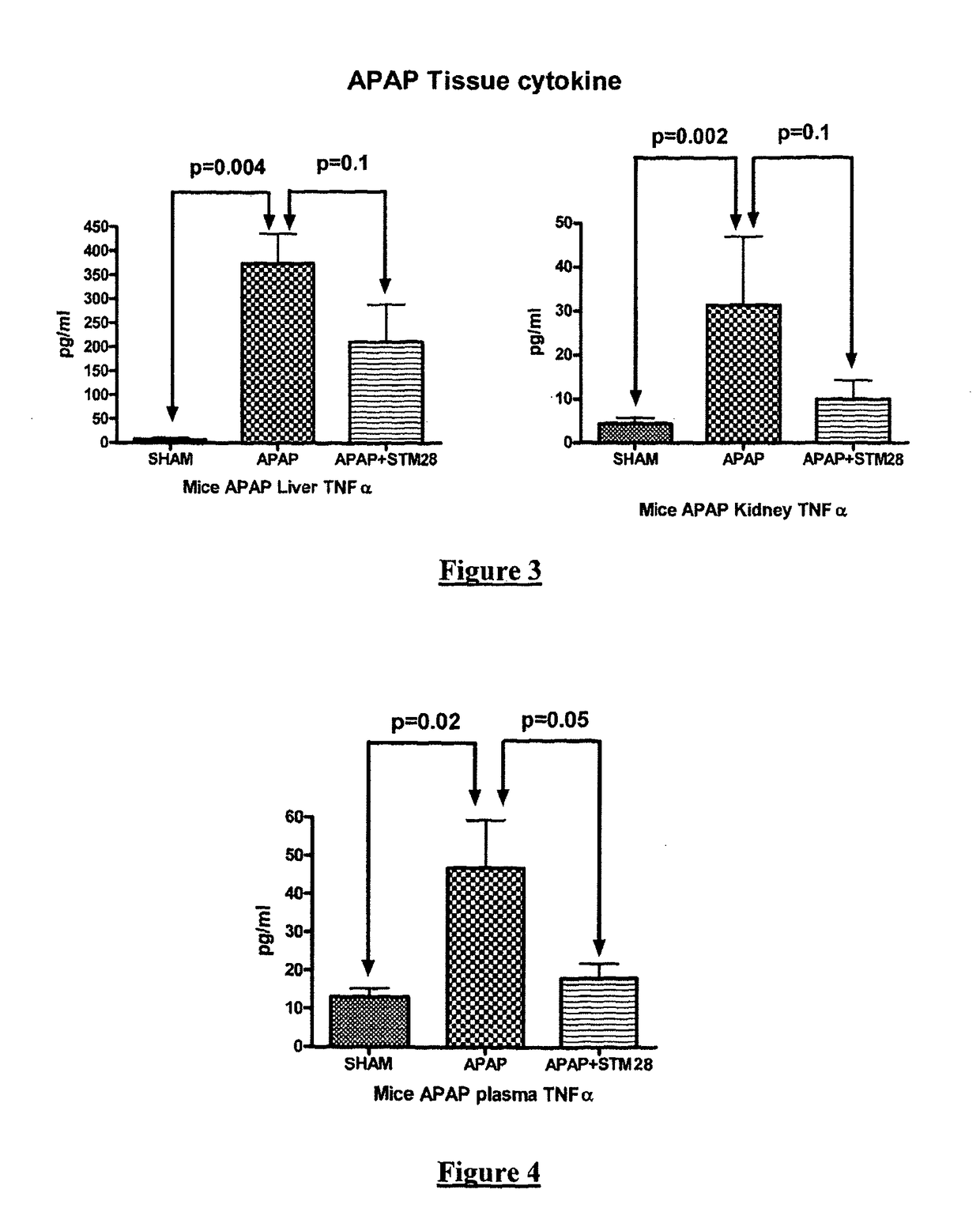Treating renal and liver dysfunction with TLR4 antagonists
a technology of renal and liver dysfunction and antagonists, which is applied in the direction of drug compositions, peptide/protein ingredients, instruments, etc., can solve the problems of liver failure of individuals to be treated, brain dysfunction and brain swelling, and renal failure in liver disease, and achieve the effect of reducing the expression of tlr4, reducing the activity of tlr4, and reducing the expression of tlr4
- Summary
- Abstract
- Description
- Claims
- Application Information
AI Technical Summary
Benefits of technology
Problems solved by technology
Method used
Image
Examples
example 1
Role of TLR4 in Acute Liver Failure
[0157]3 groups of Cd1 male mice were studied. Sham, APAP (acetaminophen, 500 mg / kg single dose IP after overnight fasting), APAP+TLR4 antagonist (STM28; 20 ug, 1 hour prior to the administration of APAP and 6 hours later). Blood was collected for biochemistry and cytokine assay. Liver, Kidney and Brain were collected for western blot and cytokine analyses and the brain frontal cortex for brain water. Animals were sacrificed at 12 hours after APAP administration.
[0158]Acetaminophen (APAP) toxicity is manifested by rapid acute liver injury, severe brain edema and renal failure. Unregulated inflammation in such an instance leads to the release of cytokines along with activation of NFkB and progressive liver injury. Administration of APAP (500 mg / kg) to the mice led to an increase in liver enzymes ALT (p=0.004) and AST (p=0.007) (FIG. 1A). Administration of a novel TLR4 antagonist (STM28) significantly reduced the [ALT (p=0.01) and AST (p=0.008) (FIG. ...
example 2
Role of TLR4 in Renal Dysfunction in Liver Disease
[0159]These experiments utilised an established animal model of cirrhosis, the bile duct ligated (BDL) rat. BDL rats may be generated by methods known in the art. For example, male Sprague-Dawley rats (200-250 g) may be used for this procedure. Following anaesthetisation, a mid-line laparotamy may be performed, the bile duct exposed, triply ligated with 4.0 silk suture, and severed between the second and third ligature. The wound is then closed in layers with absorbable suture, and the animal allowed to recover in a quiet room before being returned to the animal storage facility.
[0160]6 groups of Sprague-Dawley rats were studied: n=6 in each group. Sham operated (these were used as a control group who had an abdominal laparotomy). Sham operated+LPS, (control group with and additional dose of Lipopolysaccharide (LPS). Bile Duct Ligation (BDL): 4 weeks, a chronic model of BDL at 4 weeks has been used to study Hepatorenal syndrome. BDL+...
example 3
Increased Renal Tubular Expression of TLR4 in Cirrhosis
[0164]Kidney biopsies were studied from 7 cirrhotic patients who presented with renal failure. Various measures were recorded for these patients as set out in Table 1 below. Transjugular Renal biopsies were performed on patients who presented with proteinuria>0.5 gm / day and / or microscopic haematuria and / or unexplained high levels of serum creatinine. Clinical data on the demographics, etiology and the biochemical parameters were collected retrospectively. Paraffin embedded Kidney sections were stained immunohistochemically with antimouse primary TLR4 (1:100, Life span bioscience, cat no LS-B2070) antibody following deparaffinisation and dehydration using the citrate Antigen retrieval method. Liver biopsy cores from patients with decompensated alcohol liver disease and patients with alcoholic hepatitis were stained for antimouse TLR4 antibody using the protocol above. The results are presented in Table 1 below and in FIGS. 17 and...
PUM
| Property | Measurement | Unit |
|---|---|---|
| temperature | aaaaa | aaaaa |
| temperature | aaaaa | aaaaa |
| time | aaaaa | aaaaa |
Abstract
Description
Claims
Application Information
 Login to View More
Login to View More - R&D
- Intellectual Property
- Life Sciences
- Materials
- Tech Scout
- Unparalleled Data Quality
- Higher Quality Content
- 60% Fewer Hallucinations
Browse by: Latest US Patents, China's latest patents, Technical Efficacy Thesaurus, Application Domain, Technology Topic, Popular Technical Reports.
© 2025 PatSnap. All rights reserved.Legal|Privacy policy|Modern Slavery Act Transparency Statement|Sitemap|About US| Contact US: help@patsnap.com



